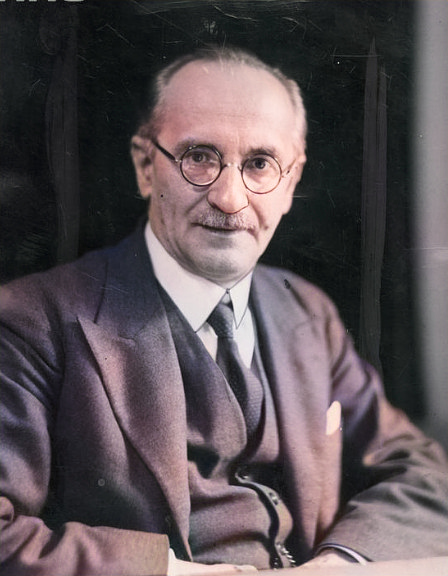
Jan Łukasiewicz (21 December 1878 – 13 February 1956)
On December 21, 1878, Polish logician and philosopher Jan Łukasiewicz was born. His work centered on philosophical logic, mathematical logic, and history of logic. However, he is best known for Polish notation and Łukasiewicz logic.
Jan Łukasiewicz – Youth and Education
Łukasiewicz grew up in Lwów and was the only child of Paweł Łukasiewicz, a captain in the Austrian army, and Leopoldina, née Holtzer, the daughter of a civil servant. He finished his gymnasium studies in philology and in 1897 went on to Lwów University, where he studied philosophy and mathematics under the philosopher Kazimierz Twardowski. In 1902 he received a Doctor of Philosophy degree under the patronage of Emperor Franz Joseph I of Austria, who gave him a special doctoral ring with diamonds. He spent three years as a private teacher, and in 1905 he received a scholarship to complete his philosophy studies at the University of Berlin and the University of Louvain in Belgium. Łukasiewicz continued studying for his habilitation qualification and in 1906 submitted his thesis to the University of Lwów. In 1906 he was appointed a lecturer at the University of Lwów where he was eventually appointed Extraordinary Professor by Emperor Franz Joseph I. He taught there until the First World War.
Academic Career
From 1915 to 1939, Łukasiewicz was full professor at the Universities of Lviv and Warsaw , and twice rector at the latter. His work there was dominated by the Lviv-Warsaw School, whose basic research on mathematical logic made the University of Warsaw a center of logic in the post-World War I period. Among his students and later colleagues was Alfred Tarski.[1] In 1919 Łukasiewicz served briefly as Polish minister of education. n the Paderewski government until 1920. He led the development of a Polish curriculum replacing the Russian, German and Austrian curricula previously used in partitioned Poland. The Łukasiewicz curriculum emphasized the early acquisition of logical and mathematical concepts. He remained a professor at the University of Warsaw until 1939 when the family house was destroyed by German bombs and the university was closed under German occupation. In this period Łukasiewicz and Stanisław Leśniewski founded the Lwów–Warsaw school of logic which was later made internationally famous by Alfred Tarski.
Emigration
He and his wife wanted to move to Switzerland but couldn’t get permission from the German authorities. Instead, in the summer of 1944, they left Poland with the help of Heinrich Scholz and spent the last few months of the war in Münster, Germany hoping to somehow go on further, perhaps to Switzerland. In 1949 he went to Dublin, where he was offered a chair at the university and worked for the rest of his life.
Polish Notation
Łukasiewicz introduced what later became known as Polish notation (prefix notation), in which the operator of an expression (e.g., a mathematical formula) is written before the operand and thus does not require parentheses: instead of 8 + 5, one writes + 8 5. Later, the reverse Polish notation (postfix notation) was derived from this, in which operators are written after their operands (e.g., 8 5 +).[2] In Łukasiewicz 1951 book, Aristotle’s Syllogistic from the Standpoint of Modern Formal Logic, he mentions that the principle of his notation was to write the functors before the arguments to avoid brackets and that he had employed his notation in his logical papers since 1929. This notation is the root of the idea of the recursive stack, a last-in, first-out computer memory store proposed by several researchers including Turing, Bauer and Hamblin, and first implemented in 1957.
A Nonclassical Logical Calculus
Jan Łukasiewicz formalized the trivalent logic Ł3 in 1920, creating the first multivalued and thus nonclassical logical calculus. However, his work also dealt with classical logic. Thus, independently of Paul Bernays [3] and Emil Leon Post, he proved the completeness and non-contradiction of classical propositional logic. In his multivalued logics he used truth-value functions, which are now called Łukasiewicz-Tarski negation and Łukasiewicz-Tarski implication. His model of 3-valued logic allowed for formulating Kleene’s ternary logic and a meta-model of empiricism, mathematics and logic, i.e. senary logic.
Philosophy of Logic
From Jan Łukasiewicz also came seminal work on the history of logic. He reconstructed Aristotelian syllogistics and, alongside Martha Kneale, discovered the importance of Stoic logic, which he considered the earliest historical form of propositional logic (today priority is attributed to the “dialecticians” Diodoros Kronos and Philon of Megara). With this reassessment, he freed the Stoa from the old and persistent judgment that it had introduced a barren formalism into logic, and added a new chapter to the history of logic.
Zbigniew Semadeni, Creating New Concepts in Mathematics: Freedom and Limitations, [9]
References and Further Reading:
- [1] Alfred Tarski and the Undefinability of Truth, SciHi Blog
- [2] Do You Speak Polish… Or Maybe Reverse Polish?, SciHi Blog
- [3] Paul Bernays and the Unified Theory of Mathematics, SciHi Blog
- [4] Łukasiewicz, Jan (1951). Aristotle’s Syllogistic from the Standpoint of Modern Formal Logic. Oxford University Press. 2nd Edition, enlarged, 1957
- [5] O’Connor, John J.; Robertson, Edmund F., “Jan Łukasiewicz”, MacTutor History of Mathematics archive, University of St Andrews.
- [6] Jan Łukasiewicz at zbMATH
- [7] Jan Łukasiewicz at the Mathematics Genealogy Project
- [8] Jan Łukasiewicz at Wikidata
- [9] Zbigniew Semadeni, Creating New Concepts in Mathematics: Freedom and Limitations, Copernicus Center for Interdisciplinary Studies @ youtube
- [10] Kotarbiński, Tadeusz, “Jan Łukasiewicz’s Works on the History of Logic”, Studia Logica 8 (1958), 57–63
- [11] Seddon, Frederick (1996). Aristotle & Łukasiewicz on the Principle of Contradiction. Ames, Iowa: Modern Logic Pub.
- [12] Woleński, Jan (1994). Philosophical Logic in Poland. Kluwer Academic Publishers.
- [13] Timeline for Jan Łukasiewicz , via Wikidata





